Atopy or “Air Borne Allergies”

You may know someone with hay fever: airborne pollens and dust particles are inhaled and soon the sneezing and sniffing begins.
A simple way to think of atopy in pets is that the pet inhales an airborne allergen but instead of sneezing and sniffing the pet gets itchy skin.
In fact, the situation is probably far more complex: the allergen is also in contact with and absorbed by the skin, causing local itching.
Airborne particles (pollen, dander etc) are harmless to someone who is not allergic to them. Allergy develops in individuals who are genetically programmed to do so.
Breeds predisposed to developing atopy include: Golden and Labrador Retrievers, West Highland White Terriers, Miniature Schnauzers, Cocker Spaniels, Shar Peis, Maltese Terriers, Carin Terriers, Lhasa Apsso, Shih Tzus, Boxers and Pugs.
Symptoms
There are many reasons that pets itch: parasites, allergy to flea bites, food allergy, secondary infections and the list goes on. Sometimes, the only symtoms of atopy are recurrent ear infections or conjunctivitis.
The following findings in the history and examination of the patient might lead to a diagnosis of atopy.
They are seasonally itchy
In dogs, atopy usually produces a seasonal itchiness. However, after several years of the disease, the itchy period may extend the whole year round. In cats, seasonal signs are less common.
Itching started at a young age
In dogs, seasonal itchiness due to atopy tends to begin earlier in life, usually within their first 3 years. Cats on the other hand, can develop seasonal itchiness at any age.
Good response to steroid medication
Whether a cat or a dog, itchiness due to atopy responds rapidly to steroid (cortisone based) medication. Itching due to insect bites also respond well to steroid medication.
Typical irritation pattern
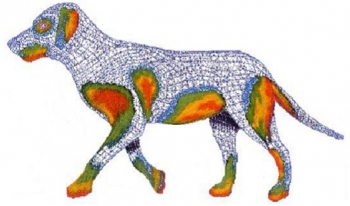
In dogs, atopy is associated with a classic irritation pattern with typical parts of the body being affected. These involve the skin around the eyes and mouth, the ears (leading to ear infections), armpits, abdomen, lower legs (especially the front feet) and the area around the anus.
It should be noted that itchiness due to food allergy has a similar pattern, but the pet’s history will be different.
In cats, there is no classic pattern of irritation.
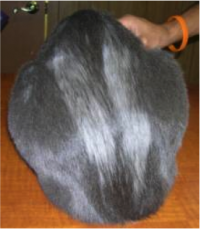 |
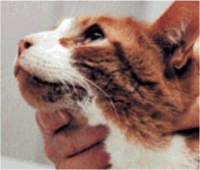 |
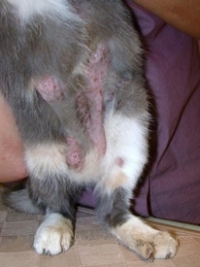 |
|---|
There are many signs of atopy in cats, but shown above from left to right are: ‘linear’hair loss from over-grooming, signs of face and ear itching, and a cat whose belly is affected by atopy.
Unfortunately, these same irritation patterns in cats can be caused by a number of other skin conditions. Up to 25% of cats can be allergic to multiple different things at once.
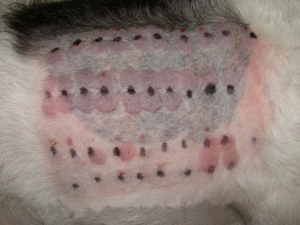
How Atopy is Diagnosed
Diagnosis of the specific allergens that cause your pet to itch is via intradermal skin testing, which is performed by a veterinary dermatology (skin) specialist. Blood allergy testing testing is also available through the clinic but it is less accurate than intra-dermal skin testing.
Many atopic patients are given an ‘assumed’ diagnosis after other common causes of itching have been ruled out. Other causes of itchiness incldue flea allergy, mite infections, food allergies, secondary bacterial and fungal infections as well as other immune-mediated diseases.
Treatment Options
It is vital to accept early that allergies are not ‘cureable’, but they can be effectively treated and managed long-term to keep your pet comfortable.
Because the allergens are in the air, it is important to realise tha tyou cannot 100% exclude your pet from contact with these particles (unless your pet wants to live ina bubble for the rest of their life!). Removing that type of grass, or ripping up that part of the garden may help a little, but it will not control all of the itching.
1. Allergen Specific Immuonotherapy and Desensitisation
This is currently the highest standard of treating atopy. Once the allergens have been diagnosed either through intra-dermal skin testing or a blood test, a custom “desensitising” vaccine is made for your pet by a veterinary dermatology specialist, that reduces their sensitivity to those particular allergens. After an initial series of injections, periodic boosters are still needed. Around 75% of pets will improve with desensitisation vaccines, and it has minimal long-term side effects.
2. Oral Steroid Medication (cortisone, triamcinolone)
Steroids, which are immune suppressing drugs, form the mainstay of short-term itchiness relief for most patients. They are cheap and effective. However, they come with a number of unwanted side -effects including but not limited to; increased appetite and thirst, increased urination, weight gain, pot-belly, urinary tract infections and negative effects to the liver. This is why they are reserved for animals with short seasonal problems, or where other therapy is not possible or ineffective. Tpically treatment is started at one dose and tapered off to ever other day usage.
3. Topical Steroid Medication (creams, sprays)
Topical steroids have fewer side effects than oral steroids as much less is absorbed by the body. Topical steroids can be helpful if the itchiness is localized to a particular area (such as just the ears). They can also be used for more widespread itchiness in the form of spray-on steroids such as Cortavance spray.
4. Cyclosporine (Atopica)
This is another immune-suppressing drug that has fewer side effects than steroids. It can help in about 80% of atopic patients. Potential side effects include tummy upsets (usually at the start of using it), and more rarely skin or internal infections and benign growths on the skin or gums. This is why regular physical examinations with bloodwork and urine testing should be performed in pets on long term cyclosporine treatment. It can also help to lower the oral dose of steroids.
5. Antihistamines (Phenergan, Zyrtec, Aerius).
Antihistamines can help reduce the itchiness in about 20% of cases. Your pet can take antihistamines for life. Certain antihistamines, such as Phenergan can cause drowsiness, otherwise the side- effects are minimal.
6. Avoidance of Allergens
This can be helpful for allergies to house dust mites. Pollen exposure can be reduced by using air-conditioning and air filters. Wiping your pet down with moist cloths after going outside and frequent bathing can also help.
7. Shampoos and Conditioners
Bathing can be very soothing for an itchy, atopic dog. However, their skin is very sensitive and easily dries out. This is why you should only use specially designed, hypoallergenic shampoos (such as Paw’s Nutriderm or Aloveen) to bathe them in. Shampooing should be followed by a hypollergenic conditioner to moisturise their skin after the bath. Ingredients such as ceramides help strengthen the skin against allergens, whilst aloe vera and oatmeal proteins help reduce the skin’s inflammation.
8. Nutritional Fatty Acid Supplements (Megaderm)
Omega 3 and 6 fatty acids are natural anti-inflammatoires and can reduce allergic sysmptoms in some patients. Megaderm is a mixtue of omega fatty acids that comes in sachets that can be easily poured onto your pet’s food. Special veterinary skin diets (such as by Royal Canin) also contain higher levels of omega 3 and 6 fatty acids.
9. New Therapies- Topical PUFAs with essential oils
Recent studies have shown improvement by atopic itchy dogs treated topically (placed on the skin) with PUFAs (polyunsaturated fatty acids) mixed with essential oils. This is very exciting as it is a therapy without side effects. The product is not commercially available yet in Australia, but watch this space..
In the end, every patient is unique. The treatment plan must be tailored to suit the individual pet and their family. Most successful treatment plans incoroporate at least 2-3 of these options.
